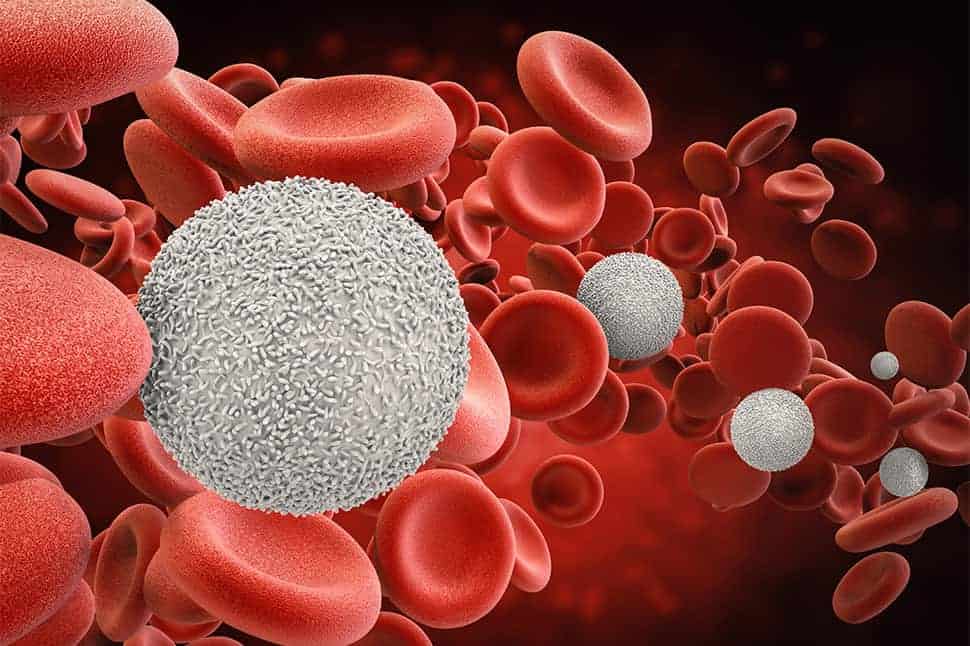September starts with Blood Cancer awareness week, so let’s talk about it. In this two-part blog, we will break down the types of blood cancer that humans are at risk of developing and delve into the potential ways that technology is allowing us to detect them early before they become a problem.
Most blood cancers find their beginnings in the bone marrow – where blood is produced. Blood cancer occurs when abnormal blood cells begin to multiply without control. This interrupts the function of normal blood cells, which try to fight off the infection and produce new blood cells.
In most blood cancer cases, these abnormal changes are linked to things beyond our control. As they occur at any time during a person’s life, they are not genetic faults that may be passed on. Over 40,000 people are diagnosed with blood cancer each year in the UK. Currently, 250,000 people are living with blood cancer (Blood Cancer UK, 2021).
Blood cancers are sometimes referred to as acute or chronic. Acute means fast-developing and chronic means slow-developing. There are different types of blood cancer, including leukaemia, myeloma, and lymphoma. In part 1 we will focus on leukaemia and myeloma.
Leukaemia
Leukaemia is a type of blood cancer that affects the blood cells in your bone marrow – usually white blood cells.
Bone marrow is a spongy tissue that is found inside some of your bones, and it is where blood cells are produced. When you suffer from leukaemia the blood cells are not produced the way they should be. As a result, you may have too many or too few blood cells that do not perform their job as they should.
Incidence rates for leukaemia in the UK are highest in people aged 85-89 between 2016-2018 (Cancer Research UK, 2021).
There are different types of leukaemia depending on the type of blood cell that is affected and how it develops. Some are acute and others are chronic (Markman, 2021):
Acute lymphoblastic leukaemia (ALL)
ALL is a type of leukaemia where the cancerous cells build up in the bone marrow. Eventually, there is no room for normal blood cells to be produced. As ALL is an acute form of leukaemia it means it develops rapidly and requires treatment right away.
People with ALL may experience fatigue, unexplained bruising, infections that last longer than normal, extreme weight loss and swollen glands.
Acute myeloid leukaemia (AML)
It is not clear what causes AML, and in most cases, there is no identifiable cause. It occurs when too many immature white blood cells are produced. This limits the number of red blood cells and platelets that can be produced.
Some symptoms of AML include tiredness, looking pale, breathlessness, frequent infections, bleeding gums or nosebleeds, rapid weight loss. The risk of developing AML increases with age and it is most commonly found in those aged 75 and over (NHS, 2019a).
Acute promyelocytic leukaemia (APL)
APL occurs when the promyelocytes (a type of blood cell) in your blood do not fully develop and become cancerous. APL may be rare, but each year there are around 160 new cases in the UK. It mostly affects those aged 30 and over.
Some symptoms of APL include:
- Blood clots
- Extreme fatigue
- Weight loss
- Infections that occur more frequently and for longer
Chronic myeloid leukaemia (CML)
CML affects the white blood cells in your body and takes many years to progress. With this cancer, the bone marrow produces too many immature white blood cells (myeloid cells) that are not fully developed and as a result do not work properly.
It can occur at any age, but commonly affects adults aged 60-65 (NHS, 2019).
CML does not usually show any symptoms in its early stages. It may only be picked up during a blood test for another illness. However, as it progresses common symptoms include:
- Tiredness
- Night sweats
- Weight loss
- Swelling in the left side of the stomach
- Shortness of breath
- High temperature
- Frequent infections
- Bone pain
Chronic lymphocytic leukaemia (CLL)
If you are diagnosed with CLL it means your body is producing too many lymphocytes which are not working as they should be. This condition develops slowly over many years. CLL is the most common leukaemia in adults. Men are twice as likely as women to get it and it is more common among those aged 70 and over.
Symptoms of CLL include fatigue, swollen lymph glands, night sweats and infections.
Childhood leukaemia
Leukaemia in children is almost always acute. It can be any one of the types mentioned above, each requiring a different treatment. Leukaemia is the most common cancer in children under 15. Over 650 children and young adults are diagnosed with leukaemia every year in the UK.
Children who may have leukaemia may experience anaemia, be easily bruised or bleed easily and get frequent infections.
Myeloma
Myeloma is a type of blood cancer that affects white blood cells called plasma cells. If you are suffering from this cancer your body has difficulties fighting off infections.
Plasma cells produce antibodies that are geared to fight off infections in your body. With myeloma, your plasma cells do not produce normal antibodies and so the infection is not fought (Blood Cancer UK, 2021a).
On top of this, too many abnormal plasma cells are produced in your bone marrow. When this happens there is not enough room for normal red and white blood cells to form, both of which are important for keeping you healthy.
Myeloma can often be referred to as multiple myeloma because this blood cancer affects the bone marrow in various parts of your body including the spine, skull, pelvis and ribs (Markman, 2021a).
In the UK incidence rates of myeloma are most common among those ages 85-89 between 2016 and 2018 (Cancer Research UK, 2021a).
Symptoms
In its early stages, myeloma may not show any symptoms. It is usually diagnosed during a routine blood or urine test (Cancer Research UK, 2021b). It does not manifest in a lump or tumour, rather it damages the bones and affects the production of healthy blood cells.
In the later stages, the symptoms associated with myeloma are (NHS, 2021):
- Persistent bone pain in the back, ribs or hips
- Tiredness
- Shortness of breath
- High levels of calcium in the blood (hypercalcaemia)
- Weight loss
- Blurred vision, dizziness or headaches caused by thickened blood (hyperviscosity)
- Repeat frequent infections
- Frequent nosebleeds, bleeding gums and heavy periods
- Weak bones
- Kidney problems
Preventive screening for Cancer – blood tests to diagnose blood cancer
Several tests can be performed to diagnose blood cancer (Blood Cancer UK, 2021b):
Full blood count
There are three main types of cells in your blood – red blood cells, white blood cells and platelets. As different blood cancers affect different cells a full blood count can highlight these problems. There is roughly a healthy range of these cells for adults. It may change slightly over time but generally is quite consistent.
If the full blood count reveals numbers higher or lower than average, it may indicate signs of blood cancer.
Liver function tests
Your liver helps clean your blood, creates blood clotting factors, proteins, and enzymes. It also stores vitamins and minerals and makes bile. The liver function test assesses how well the liver is working. A blood sample is tested for levels of different substances that may indicate abnormalities (OncoLink, 2020).
Peripheral blood film
This is a short test that looks at your blood cells (red, white and platelets) to see if they are forming correctly. It checks their size and shape to determine if they are healthy. If not, through this test it may be possible to find signs of potential risks of blood cancer.
Immunophenotyping
This test is also known as flow cytometry. It looks at the proteins on the surface of the cells and determines if any are abnormal. It is normally done on cells collected from a blood test or bone marrow biopsy.
As it is a very sensitive test it will always catch any abnormal cells if they exist. With this test, you will be able to determine the type of blood cancer and provide a clearer prognosis for the patient.
Erythrocyte Sedimentation Rate (ESR)
The ESR is the indirect measure of the degree of inflammation that may be present in the body. It measures the rate of fall of erythrocytes (sedimentation of red blood cells) in a tall, thin tube. Usually, red blood cells settle slowly leaving little clear plasma. When someone has an inflammation, due to increased proteins the red blood cells fall a lot more quickly increasing the ESR.
The ESR is a non-specific test which means it is not able to determine a specific illness, however, based on its results further investigation may be done to find what the problem may be (Lab Tests Online, 2020).
Echelon Health Preventive Health Assessments
Core Cancer
Fortunately, 12% of leukaemia and 14% of myeloma cases are preventable. This means that with tests and health assessments we may be able to catch many blood cancers and save thousands of lives each year.
At Echelon Health we provide world-class health assessments that detect up to 94% of preventable diseases that lead to premature death in men and women.
Our Core Cancer Assessment was created to detect the highest risk cancers at their earliest possible stage. It screens for cancers such as breast, prostate, colon, pancreatic, liver, thyroid and more. It also screens for blood cancers – leukaemia and lymphoma.
The list of tests performed during this assessment is as follows:
- Blood tests
- CT Abdomen
- CT Pelvis
- CT Virtual Colonoscopy
- MRI Prostate
- Ultrasound Thyroid
- Ultrasound Testes/ Ovaries
- Digital Mammogram
The blood tests are very comprehensive and check over 40 parameters including:
| Disease Detection | Test |
| Anaemia | Full Blood Count |
| Infection | Full Blood Count |
| Clotting Disorders | Platelet Count |
| Iron Deficiency | Iron Levels |
| Kidney Failure | Renal Function |
| Salt Disturbances | Electrolytes |
| Liver Disease | Liver Function Tests |
| Alcohol Damage/Excess | Gamma Glutemyl Transference |
| High Cholesterol | Total HDL, LDL Cholesterol |
| Vitamin D Deficiency | Vitamin D |
| Hypogonadism (Men only) | Testosterone, Luteinising Hormone (LH), Folicle Stimulating Hormones (FSH) |
| Diabetes | Glucose & Glycosylated Haemoglobin |
| Under / Over Active Thyroid | Thyroid Function Tests |
| Breast and Ovarian Cancer (Women only) | CA 19-9, CEA Tumor Markers |
| Prostate Cancer (Men only) | PSA |
| Leukaemia | Full Blood Count & ESR |
| Lymphoma | Full Blood Count & ESR |
| Myeloma | Full Blood Count & ESR |
If you would like to find your peace of mind, contact us today! Don’t forget to download our brochure to read more about the Core Cancer health assessment and our other packages.
Sources:
Blood Cancer UK (2021). Blood cancer. Available at: https://bloodcancer.org.uk/understanding-blood-cancer/ (Accessed 20/10/2021).
Cancer Research UK (2021). Leukaemia (all subtypes combined) statistics. Available at: https://www.cancerresearchuk.org/health-professional/cancer-statistics/statistics-by-cancer-type/leukaemia#heading-Zero (Accessed 20/10/2021).
Markman, M. MD (2021). Leukemia. Cancer Treatment Centers of America. Available at: https://www.cancercenter.com/cancer-types/leukemia (Accessed 20/10/2021).
Markman, M. MD (2021)a. Multiple Myeloma. Cancer Treatment Centers of America. Available at: https://www.cancercenter.com/cancer-types/multiple-myeloma (Accessed 20/10/2021).
NHS (2019) Overview Chronic myeloid leukaemia. Available at: https://www.nhs.uk/conditions/chronic-myeloid-leukaemia/ (Accessed 20/10/2021).
NHS (2019)a Causes Acute myeloid leukaemia. Available at: https://www.nhs.uk/conditions/acute-myeloid-leukaemia/causes/ (Accessed 20/10/2021).
Blood Cancer UK (2021)a. Myeloma. Available at: https://bloodcancer.org.uk/understanding-blood-cancer/myeloma/ (Accessed 20/10/2021).
NHS (2021). Overview Multiple Myeloma. Available at: https://www.nhs.uk/conditions/multiple-myeloma/ (Accessed 20/10/2021).
Cancer Research UK (2021)a. Myeloma statistics. Available at: https://www.cancerresearchuk.org/health-professional/cancer-statistics/statistics-by-cancer-type/myeloma (Accessed 20/10/2021).
Blood Cancer UK (2021)b. Blood cancer tests. Available at: https://bloodcancer.org.uk/understanding-blood-cancer/tests-diagnosis/ (Accessed 20/10/2021).
Lab Tests Online (2020). Erythrocyte Sedimentation Rate (ESR). Available at: https://labtestsonline.org.uk/tests/erythrocyte-sedimentation-rate-esr (Accessed 20/10/2021).
OncoLink (2020). Liver Function Test (LFT). Available at: https://www.oncolink.org/cancer-treatment/procedures-diagnostic-tests/blood-tests-tumor-diagnostic-tests/liver-function-test-lft (Accessed 20/10/2021).
Cancer Research UK (2021)b. Blood tests for myeloma. Available at: https://www.cancerresearchuk.org/about-cancer/myeloma/getting-diagnosed/tests/blood-tests (Accessed 20/10/2021).



